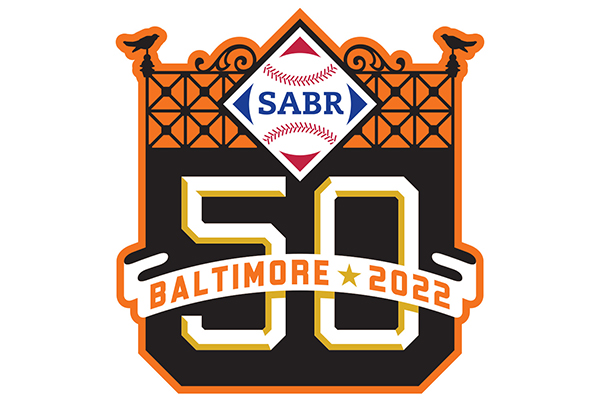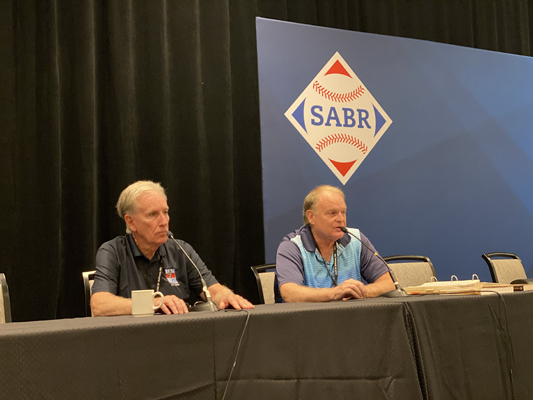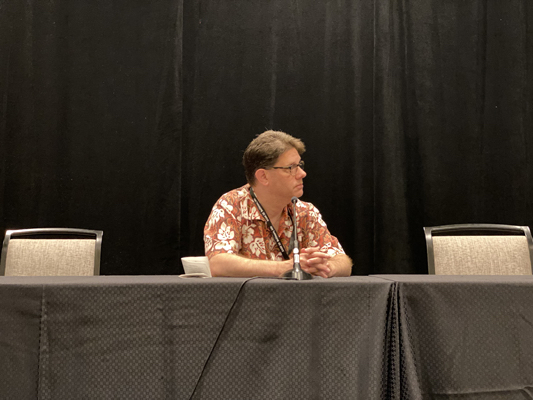SABR 50: Listen to highlights from Babe Ruth panel with Mike Gibbons, Bill Jenkinson, Tom Shieber
At SABR 50 on Thursday, August 18 in Baltimore, we held a special panel discussion on the life and legacy of Babe Ruth, who was born in Baltimore in 1895, learned to play baseball at St. Marys Industrial School for Boys, and began his professional career at the age of 19 with the minor-league Baltimore Orioles in 1914.
Panelists included Bill Jenkinson, author of The Year Babe Ruth Hit 104 Home Runs; Tom Shieber, Senior Curator at the National Baseball Hall of Fame Library (pinch-hitting for author Jane Leavy); and moderator Mike Gibbons, Director Emeritus and Historian for the Babe Ruth Birthplace and Museum.
- Audio: Click here to listen to the SABR 50 Babe Ruth Panel (MP3; 55:48)
Here are some highlights:
On Ruth’s lasting impact in baseball
- Gibbons: “I taught a college writing course for 23 years … and as a way of introducing myself as what I did for a full-time living, I would ask the students, (usually) 20 kids sitting out in the room, how many of you have ever heard of Babe Ruth? And they all raised their hand. … I started teaching in the late 1980s, so I would (also ask) how many know Brooks Robinson? But over time, even here (in Baltimore) he went away. Cal Ripken? He faded. Babe Ruth never fades.”
On Ruth’s potential to be a major-league manager
- Jenkinson: “In 1934, Babe returned from Japan (with) the American League All Stars, who successfully performed there for three weeks. He was a field manager for that group of very large egos and when (Philadelphia A’s manager) Connie Mack, of all people, came back to the United States, he gave a talk at a local institution in Philadelphia and raved, absolutely raved, about Babe Ruth’s managerial abilities and gave him a carte blanche recommendation for management. It never happened.”
On Ruth’s integration efforts during his baseball offseason tours
- Jenkinson: “He (Babe Ruth) had approximately 200 barnstorming offers when that (1927) season ended and, of course, selected only a few. And he made sure of the fact that a couple of those teams were against African-American players, which included a team from Cuba which was integrated. And that was the start of a lifelong commitment to racial integration.”
On Ruth’s underappreciated in-game intelligence
- Shieber: “I think one thing that’s underestimated about Ruth. … He had to change his batting style, his batting stance very often, and he had the ability to do that. … Today you go to Triple-A or whatever, but you’ve got to be able to change and he easily had that ability. He was constantly tinkering with what he did because they were pitching him very smart. It’s not like they’re idiots and they’re just grooving it every time and he just happened to hit it out. So that was one thing that’s really not talked about with Babe Ruth’s genius, it wasn’t a God-given talent. There’s a certain amount of God-given talent there, but he was a really smart batsman.”
On stories of Ruth’s power
- Jenkinson: “I remember in 1953 when I went to my first big-league game, my dad took me to Shibe Park for the annual Phillies and Athletics exhibition game and we’re sitting along the third-base line and the A’s had Gus Zernial playing left field and the Phillies had Del Ennis. Big burly guys, home run hitters. I asked my dad who hits the ball farther and I still remember him turning toward me and saying, ‘Why do you want to know that?’ I said, ‘I don’t know, I just want to know.’ So he regaled me with about half an hour of stories of balls that he had seen hit, including a home run that Babe Ruth hit directly over his head when he was a 14-year-old kid sitting in a 25-cent seat atop a house across 20th Street.”
Transcription assistance by Mitchell Case.
For more coverage of SABR 50, visit SABR.org/convention.
Originally published: September 15, 2022. Last Updated: September 16, 2022.




